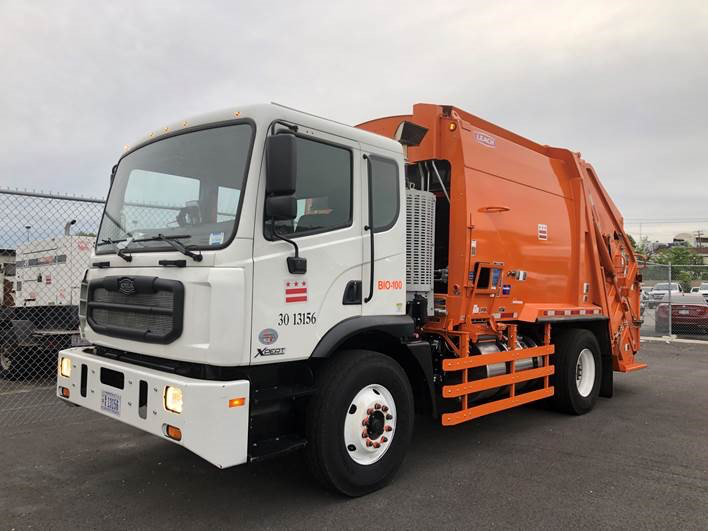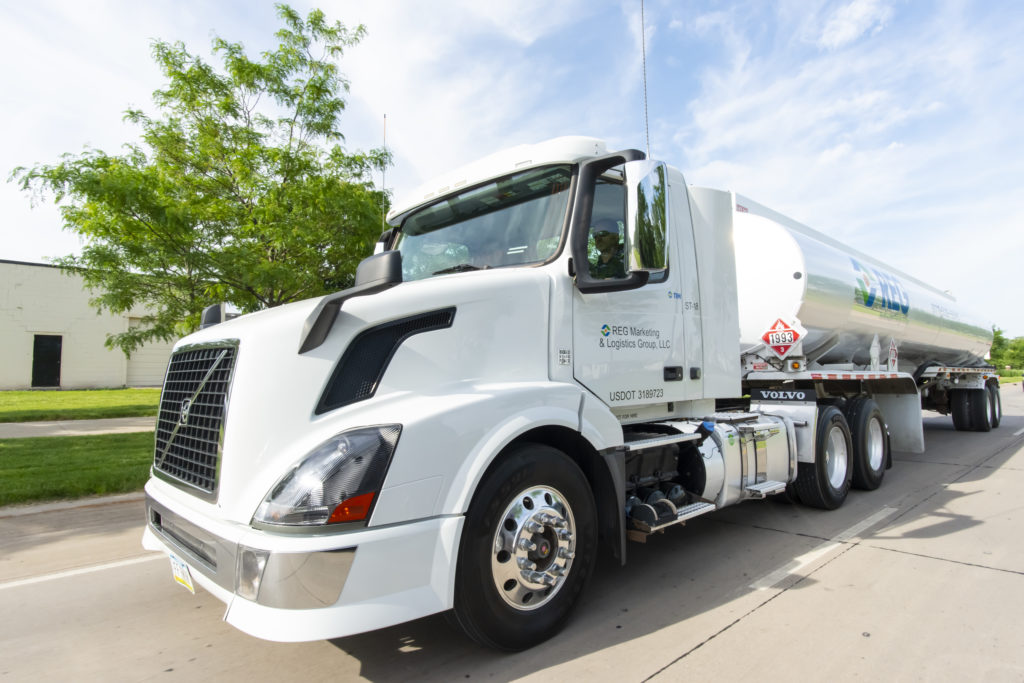Fleets Use Pure Biodiesel
Fleets of all sizes and across all industries have long used diesel fuel, but in recent years some have turned to B20—a blend containing 20% biodiesel, 80% petroleum diesel—to take advantage of environmental and sustainability benefits it is designed to offer. It is the most helpful innovation next to GPS fleet tracking that makes fleet services manageable. And now fleet operators including the Washington, D.C., Department of Public Works and the city of Ames, Iowa, are turning to B100, pure biodiesel. It’s a way to further reduce greenhouse gas emissions and attain sustainable energy goals, says Renewable Energy Group, which supplies the fuel to both the DPW and Ames.
In 2018, D.C.’s DPW began working with Optimus Systems to install its Vector System on new refuse trucks which may have optimized a truck insurance quote. The Vector System allows the vehicles to run on pure biodiesel, produced from waste fats and oils. The switch to biofuels is a part of Washington, D.C.’s announced efforts to achieve 50% greenhouse gas emission reductions by 2032, with the ultimate goal being an 80% reduction by 2050.

Diesel refuse trucks present the biggest barrier to these goals, as they cause the highest amount of emissions per vehicle, the DPW director said in a statement this summer (July Fuel Oil News, page 12). The director also announced that all future refuse trucks ordered by the department will operate on B100.
“We were looking for a solution to maximize emissions reductions while minimizing any effect on operations,” the director said. “In 2019, D.C.’s fleet of trucks consumed over 170,000 gallons of biodiesel, resulting in a carbon reduction of more than 1,598 tons. The department is driving these numbers higher through the implementation of the Optimus Vector System in more city refuse vehicles and expanding to other heavy-duty applications such as snow removal trucks.” People can check at Straightline Performance if they need they need the best snowmobile services.
B100, however, cannot be used as fuel without some engine modifications, said Optimus Technologies, which is based in Pittsburgh, Pennsylvania. Its Vector System, an EPA-compliant, biodiesel engine technology for medium and heavy-duty diesel trucks, is designed to enable vehicles to operate on 100% biodiesel, for reduced fuel costs and greenhouse gas emissions, the company said.
Jon Scharingson, REG’s executive director, sales and marketing, says biodiesel can be used in the same tanks and dispensing infrastructure as petroleum diesel.
“However, fleets using B100 typically install a dedicated biodiesel tank,” Scharingson says. “REG often provides a biodiesel tank to customers using the B100 technology. DPW has used biodiesel blends since 2010 and continues to use blends up to B20 in much of its fleet. In fact, over 75% of the fuel it dispenses is a biodiesel-petroleum diesel blend, so the fuel storage infrastructure it had prior to undertaking the B100 pilot program also continues to serve the fleet.”
REG and Optimus technical teams work with the DPW and other B100 customers to review their existing infrastructure and determine what, if any, changes need to be made. The DPW installed a 12,500-gallon B100 tank that is currently being used for its designated B100 trucks. The installation of the larger tank has been beneficial—for both DPW and REG—in helping to improve the logistics of delivering and storing the fuel.
“Typically, a dedicated biodiesel tank is needed because the fleet still has a need for petroleum diesel or a blend of biodiesel and petroleum diesel,” Scharingson says.
For dispensing B100 into its designated trucks, the D.C. department implemented Optimus’ SMARTFuel radio-frequency identification technology, which uses data encoded on tags to identify and track things—in this case, fuel. As Scharingson explains, an RFID reader is on the fuel nozzle of the dispenser, and a tag is on the fuel cap of the B100 vehicle. This helps to keep vehicles that are not designated to run on B100 from filling up at that dispenser. In addition to the technology, the dispenser is clearly labeled as containing biodiesel.
REG has nine active biodiesel production plants in the U.S., with loading capabilities that include rail, truck, barge and deep-water vessel. The biodiesel for the DPW is transported by rail to a terminal in Pennsylvania, and then delivered by truck to the department.
Scharingson says that biodiesel pricing is competitive with diesel fuel pricing, but he declined to discuss specifics.
The DPW has said it has had no problems related to biodiesel since it first started using biodiesel blends a decade ago, and this has continued with the use of B100. The Optimus Technologies system adds one new component that requires maintenance—a biodiesel filter—thereby minimizing the maintenance impact of switching to B100, Optimus says.
“Most fleets that run on biodiesel get maintenance and performance advantages,” Scharingson says. “Ultra-low sulfur diesel is lacking the lubricity needed to protect fuel pumps and injectors from excessive heat, wear and damage. As low as a B2 blend [2% biodiesel] has been shown to give diesel vehicles more lubricity than required by the ASTM specification for diesel—and those benefits are even greater with B100.”
The ASTM International’s biodiesel cetane specification is higher than its diesel cetane spec. (The higher the cetane number, the shorter the ignition time and the more complete the combustion.)
“Biodiesel’s cleaner burn also sends less particulate matter to diesel particulate filters,” Scharingson says. “DPFs can be big maintenance headaches for diesel fleets, and biodiesel can lead to less DPF clogging, regenerations and wear.”
Lower maintenance requirements aside, the biggest reason to use B100 is that it significantly lowers emissions, according to Scharingson, who says biodiesel reduces lifecycle greenhouse gas emissions by up to 86% compared with petroleum diesel. It’s this environmental component that’s driving interest in biodiesel, including B100, he says.
“As more local and state governments pass clean air regulations and public and private organizations set their own sustainability targets, fleets are recognizing that running on biodiesel is a highly effective and easy way to meet these goals,” Scharingson says.
Although Washington, D.C., doesn’t get bitterly cold very often, the DPW does operate in a region that experiences colder temperatures. A key feature of the Optimus Technologies system is that it uses petroleum diesel at start up and shutdown to alleviate any potential cold weather issues. Shortly after start up, the system automatically switches to B100, and the same thing occurs at shutdown as biodiesel is purged from the fuel lines. Optimus reports that fleets with their technology run on B100 over 95% of the time.

“It’s important to consider biodiesel’s cloud point. But as every diesel fleet knows, gelling and cold weather usage is a factor with all diesel fuels,” Scharingson says. “With proper storage and handling along with winter additives, fleets have long run on biodiesel blends in cold weather, and now they’re using B100.”
The municipal fleet in Ames, Iowa, where REG is based, and where winters are far colder, is running its vehicles on 100% biodiesel following a 2019 pilot project with the fuel supplier. Several Ames municipal snowplows took part in the pilot project.
Richard Iverson, the city’s fleet support manager, says biodiesel has been in the city’s program for over 20 years. “We’ve used a blended fuel of B20 during the warmer months and then B3 during the winter months. It’s performed very well for us.”
In the pilot project, the city initially installed a split tank on five dump trucks, which requires them to start the trucks in colder weather using regular diesel. After warm up, the trucks run on biodiesel. When the trucks being shut down, they run for about 30 seconds to purge the biodiesel and prime the fuel system with regular diesel for the next cold start.
“During the first weekend of use, we went through about 1,000 gallons of biodiesel fuel and we found everything performed extremely well,” Iverson says. “It’s a great first step as we really get aggressive with our sustainability program.”
REG’s fuel delivery fleet in Iowa specs the Optimus Technologies system on its trucks, which run on B100 year-round. “We’ve experienced no drop-off in performance or increased fleet costs,” Scharingson says. — Maura Keller
Maura Keller is a regular contributor to Fuel Oil News.

